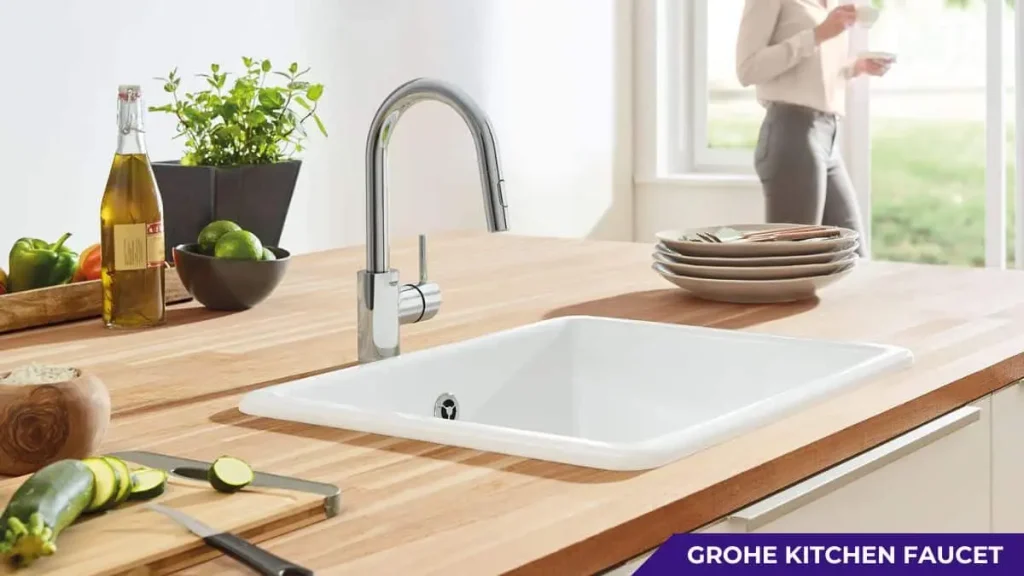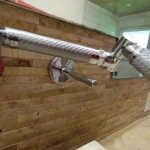To remove a Grohe kitchen faucet, shut off water supply, disconnect hoses, and use wrench to uninstall faucet. Removing a Grohe kitchen faucet involves a few simple steps that can be easily completed with basic tools and some careful handling.
Grohe faucets are known for their quality and durability, but over time, they may need to be replaced or upgraded. Whether you are installing a new faucet or repairing an existing one, knowing how to remove a Grohe kitchen faucet properly is essential.
In this guide, we will walk you through the step-by-step process of removing a Grohe kitchen faucet, so you can complete the task with confidence and ease.
Why Do I Need To Remove The Grohe Kitchen Faucet?
Why do I need to remove the Grohe kitchen faucet? Whether it’s for repair, replacement, or cleaning, knowing how to remove a Grohe kitchen faucet is essential for maintaining a functional and efficient kitchen. Understanding the process can save time and frustration, ensuring that the task is completed successfully.
Importance Of Knowing How To Remove A Grohe Kitchen Faucet
Removing a Grohe kitchen faucet may be necessary for various reasons, including repairing leaks, replacing worn-out parts, or deep cleaning to maintain its performance. Having the knowledge and skills to carry out this task can prevent costly damage and ensure the longevity of the faucet.

Steps For Removing A Grohe Kitchen Faucet
- Turn off the water supply to the faucet.
- Disconnect the water supply lines from the faucet.
- Remove the mounting nut securing the faucet in place.
- Gently lift the faucet from the sink or countertop.
Related Post: How to Remove Moen Kitchen Faucet
Tools And Materials
To remove a Grohe kitchen faucet, you will need some basic tools and materials such as an adjustable wrench, pliers, a screwdriver, and a basin wrench. Make sure you turn off the water supply before starting the removal process to avoid any accidents.
Removing a Grohe kitchen faucet may seem like a daunting task, but with the right tools and materials, the process can be made easier. In this section, we will discuss the essential tools and additional materials needed to remove a Grohe kitchen faucet successfully.
Essential Tools For The Removal Process
To remove a Grohe kitchen faucet, you will need the following tools:
- Adjustable wrench
- Basin wrench
- Phillips screwdriver
- All-purpose cleaner
- Bucket
- Teflon tape
The adjustable wrench is essential for removing the mounting nuts holding the faucet. The basin wrench is required to reach the mounting nuts in tight spaces. The Phillips screwdriver is necessary for removing any screws holding the faucet in place. The all-purpose cleaner is needed to clean the area around the faucet, while the bucket is required to catch any water that may drip during the removal process.
Finally, Teflon tape is necessary to seal any connections after the installation of the new faucet.
Preparation
When removing a Grohe Kitchen Faucet, proper preparation is essential to ensure a smooth process. Below, we will outline the key steps you need to take to prepare for the removal of your faucet.
Shutting Off The Water Supply
Before beginning the removal process, locate the shut-off valves for the water supply under the sink. Turn the shut-off valves clockwise to stop the flow of water to the faucet. Open the faucet to release any remaining water pressure in the lines.
Clearing The Area Around The Faucet
- Remove any items stored under the sink to create space for easy access to the faucet.
- Clear the countertop surrounding the faucet to provide a clutter-free work area.
- Have a bucket or container ready to catch any water that may drip during the removal process.
Removing The Faucet
When it comes to renovating a kitchen, removing the faucet is often a necessary step. Whether you’re replacing it with a new model or need to access the sink for other maintenance, knowing how to properly remove a kitchen faucet is essential.
Detaching The Water Lines
Before you can remove the faucet, you’ll need to detach the water lines. Begin by turning off the water supply to the sink. This can typically be done by locating the shut-off valves beneath the sink and turning them clockwise until they are fully closed. Once the water supply is off, use an adjustable wrench to disconnect the water lines from the faucet. Be sure to have a bucket or towel handy to catch any excess water that may drain out during this process.
Unscrewing The Mounting Nut
With the water lines detached, the next step is to unscrew the mounting nut that secures the faucet in place. This nut is typically located beneath the sink and can be accessed by reaching up behind the sink basin. Use a basin wrench or adjustable wrench to loosen and remove the nut. Once the nut is removed, the faucet should be free to lift out of its mounting hole in the sink.
Read Also: Moen Bathroom Faucet Has Low Water Pressure
Inspecting And Cleaning
When it comes to maintaining your Grohe kitchen faucet, inspecting and cleaning it regularly is essential to ensure its longevity and optimal performance.
Checking For Any Damage
Regularly inspecting your Grohe kitchen faucet for any damage is imperative for preventing potential leaks and ensuring its smooth operation. Here’s how to check for any damage:
- Inspect the faucet body, handles, and spout for any visible cracks or signs of wear and tear.
- Check the base and connections for any leaks or loose fittings.
- Examine the aerator for mineral buildup or clogs that may affect water flow.
Cleaning The Sink Area
Keeping the sink area clean is vital for maintaining the overall functionality and appearance of your Grohe kitchen faucet. Here’s how to effectively clean the sink area:
- Remove any debris or food particles from the sink to prevent clogs and potential damage to the faucet.
- Use a non-abrasive cleaner to wipe down the faucet, handles, and spout to remove any stains or water spots.
- Regularly clean the aerator to remove mineral deposits that can affect water flow.
Troubleshooting
When it comes to troubleshooting the removal of your Grohe kitchen faucet, it’s important to be prepared for potential challenges that may arise during the process. Addressing these issues effectively can save time and frustration, ensuring a smooth removal experience.
Dealing With Stubborn Connections
If you encounter stubborn connections when attempting to remove your Grohe kitchen faucet, there are a few steps you can take to facilitate the process. First, ensure that you have turned off the water supply to the faucet to avoid any leaks or spills. Next, use a wrench or pliers to carefully loosen the connections, applying steady pressure to avoid damaging the fixtures. If the connections remain resistant, applying a lubricant can help to loosen the grip and make removal easier.
Addressing Unexpected Challenges
During the removal process, unexpected challenges may arise that require quick thinking and problem-solving skills. In the event of a stubborn nut or bolt, utilizing a penetrating oil can help to loosen the grip and facilitate removal.
Additionally, inspect the area for any hidden screws or fastenings that may be holding the faucet in place, ensuring that all components are accounted for before proceeding. If you encounter any unexpected challenges, take a step back, assess the situation, and approach it with patience and diligence.
Installing A New Faucet
When it comes to upgrading your kitchen, installing a new faucet can make a significant impact. Whether you’re replacing a worn-out fixture or updating the style of your kitchen, selecting the right faucet and installing it correctly is crucial.
Choosing A Replacement Faucet
Before diving into the installation process, it’s essential to choose a replacement faucet that suits your needs and complements your kitchen’s design. Consider factors such as the faucet style, finish, features, and compatibility with your sink. With a wide variety of options available, research and compare different models to find the best fit for your kitchen.
Step-by-step Installation Process
Once you’ve selected the perfect replacement faucet, it’s time to proceed with the installation. Follow these simple steps to ensure a smooth and successful installation:
- Turn off the water supply: Locate the shut-off valves under the sink and turn them clockwise to shut off the water supply.
- Remove the old faucet: Use a wrench to disconnect the supply lines and mounting nuts, then carefully lift out the old faucet.
- Clean the sink area: Thoroughly clean the area around the sink to prepare for the installation of the new faucet.
- Install the new faucet: Follow the manufacturer’s instructions to install the new faucet, connecting the supply lines and securing the mounting nuts.
- Test for leaks: Once the new faucet is in place, turn on the water supply and check for any leaks. Make any necessary adjustments to ensure a tight seal.
- Enjoy your new faucet: With the installation complete, you can now enjoy the enhanced functionality and aesthetic appeal of your new kitchen faucet.
Final Checks And Maintenance
After successfully removing your Grohe kitchen faucet, it’s crucial to conduct final checks and maintenance to ensure proper functionality and longevity of the new faucet.
Ensuring Proper Functionality
- Check for any leaks by turning on the water supply.
- Test both hot and cold water to confirm smooth flow.
- Inspect the handle and spout for any loose parts.
Maintaining The New Faucet For Longevity
- Regularly clean the faucet with a mild soap to prevent buildup.
- Check for mineral deposits and remove them using vinegar solution.
- Ensure all connections are tight and secure to prevent leaks.
Conclusion
To sum up, removing a Grohe kitchen faucet can be a straightforward task with the right guidance. By following the steps outlined in this blog post, you can successfully uninstall your faucet and make way for a new one. Remember to take your time and be careful throughout the process.
Happy DIY-ing!



